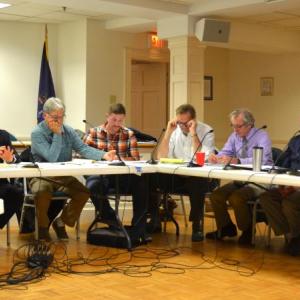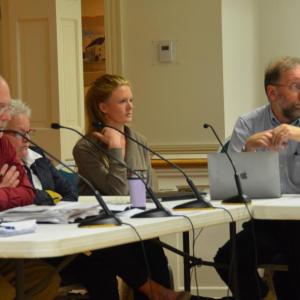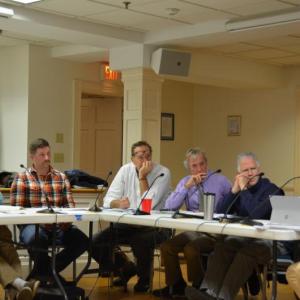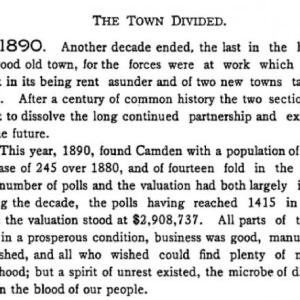Camden Rockport select boards consider ‘Raise the Floor’ idea to increase state education dollars
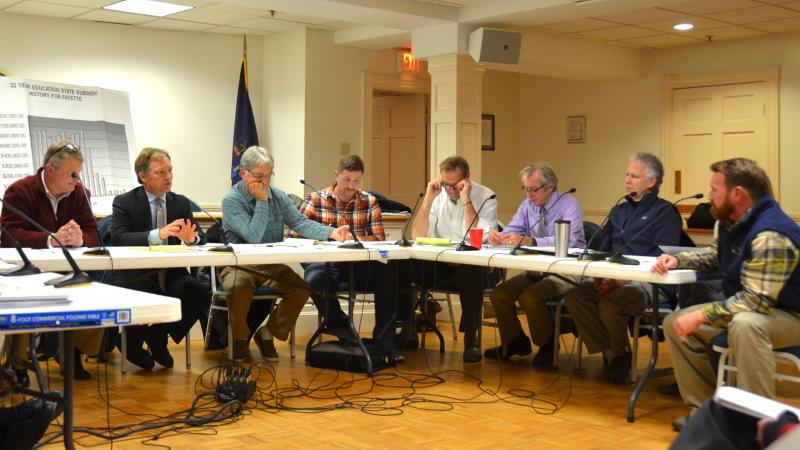 Fayette Town Manager Mark Robinson, Preti Flaherty attorney Dan Walker, Camden Select Board Chairman Bob Falciani, Camden Select Board member Taylor Benzie, Rockport Select Board Chairman Doug Cole, Rockport Town Manager Rick Bates, Camden Select Board member Marc Ratner, Camden Town Manager Audra Caler-Bell, and Rep. Owen Casas, I-Rockport., Oct. 20, Rockport. (Photo by Lynda Clancy)
Fayette Town Manager Mark Robinson, Preti Flaherty attorney Dan Walker, Camden Select Board Chairman Bob Falciani, Camden Select Board member Taylor Benzie, Rockport Select Board Chairman Doug Cole, Rockport Town Manager Rick Bates, Camden Select Board member Marc Ratner, Camden Town Manager Audra Caler-Bell, and Rep. Owen Casas, I-Rockport., Oct. 20, Rockport. (Photo by Lynda Clancy)
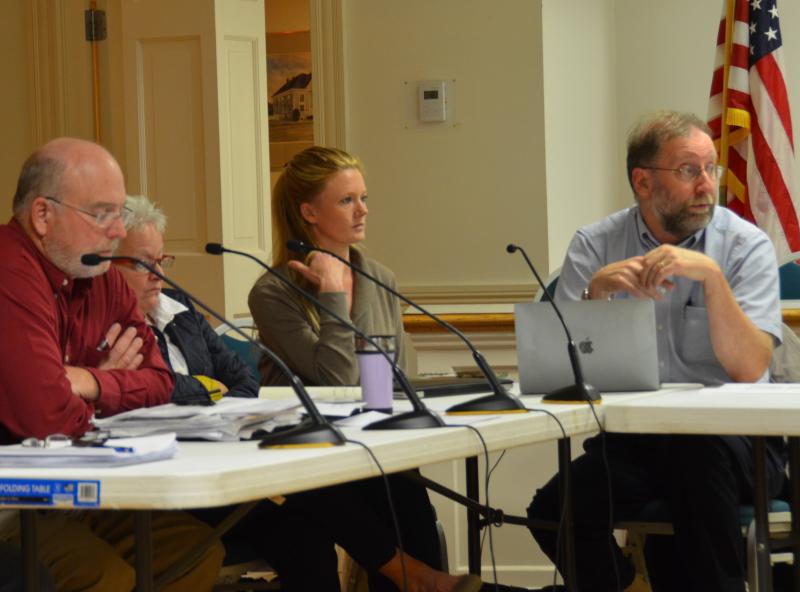 Rockport Select Board member Jeff Hamilton, Camden Select Board member Alison McKellar and Rockport Select Board member Ken McKinley. (Photo by Lynda Clancy)
Rockport Select Board member Jeff Hamilton, Camden Select Board member Alison McKellar and Rockport Select Board member Ken McKinley. (Photo by Lynda Clancy)
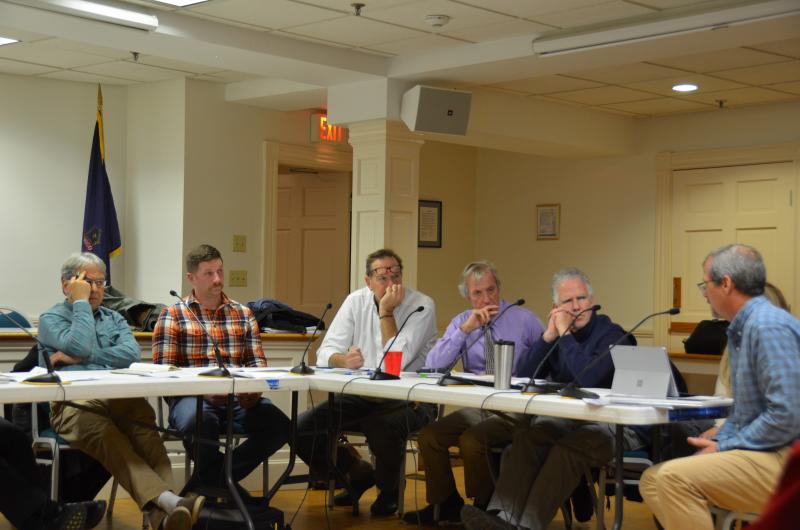 Camden resident Pete Orne, far right, talks about the Raise the Floor legislation with (l-r) Camden Select Board Chairman Bob Falciani, Camden Select Board member Taylor Benzie, Rockport Select Board Chairman Doug Cole, Rockport Town Manager Rick Bates, Camden Select Board member Marc Ratner, and Camden Town Manager Audra Caler-Bell. (Photo by Lynda Clancy)
Camden resident Pete Orne, far right, talks about the Raise the Floor legislation with (l-r) Camden Select Board Chairman Bob Falciani, Camden Select Board member Taylor Benzie, Rockport Select Board Chairman Doug Cole, Rockport Town Manager Rick Bates, Camden Select Board member Marc Ratner, and Camden Town Manager Audra Caler-Bell. (Photo by Lynda Clancy)

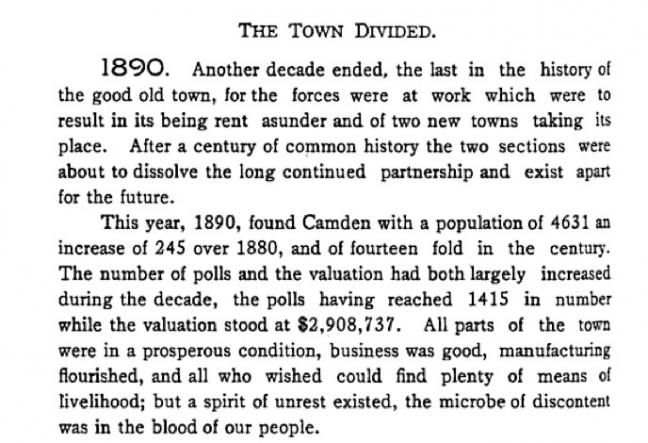 From the “History of Camden and Rockport, Maine” by Reuel Robinson
From the “History of Camden and Rockport, Maine” by Reuel Robinson
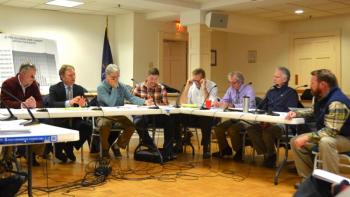 Fayette Town Manager Mark Robinson, Preti Flaherty attorney Dan Walker, Camden Select Board Chairman Bob Falciani, Camden Select Board member Taylor Benzie, Rockport Select Board Chairman Doug Cole, Rockport Town Manager Rick Bates, Camden Select Board member Marc Ratner, Camden Town Manager Audra Caler-Bell, and Rep. Owen Casas, I-Rockport., Oct. 20, Rockport. (Photo by Lynda Clancy)
Fayette Town Manager Mark Robinson, Preti Flaherty attorney Dan Walker, Camden Select Board Chairman Bob Falciani, Camden Select Board member Taylor Benzie, Rockport Select Board Chairman Doug Cole, Rockport Town Manager Rick Bates, Camden Select Board member Marc Ratner, Camden Town Manager Audra Caler-Bell, and Rep. Owen Casas, I-Rockport., Oct. 20, Rockport. (Photo by Lynda Clancy)
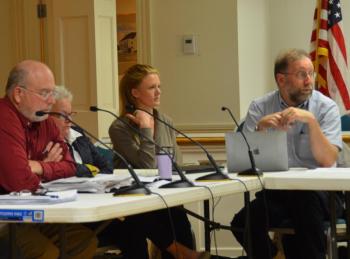 Rockport Select Board member Jeff Hamilton, Camden Select Board member Alison McKellar and Rockport Select Board member Ken McKinley. (Photo by Lynda Clancy)
Rockport Select Board member Jeff Hamilton, Camden Select Board member Alison McKellar and Rockport Select Board member Ken McKinley. (Photo by Lynda Clancy)
 Camden resident Pete Orne, far right, talks about the Raise the Floor legislation with (l-r) Camden Select Board Chairman Bob Falciani, Camden Select Board member Taylor Benzie, Rockport Select Board Chairman Doug Cole, Rockport Town Manager Rick Bates, Camden Select Board member Marc Ratner, and Camden Town Manager Audra Caler-Bell. (Photo by Lynda Clancy)
Camden resident Pete Orne, far right, talks about the Raise the Floor legislation with (l-r) Camden Select Board Chairman Bob Falciani, Camden Select Board member Taylor Benzie, Rockport Select Board Chairman Doug Cole, Rockport Town Manager Rick Bates, Camden Select Board member Marc Ratner, and Camden Town Manager Audra Caler-Bell. (Photo by Lynda Clancy)
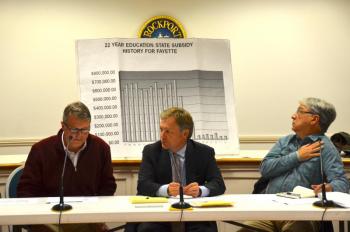
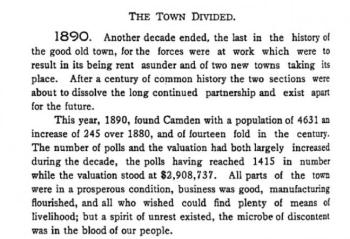 From the “History of Camden and Rockport, Maine” by Reuel Robinson
From the “History of Camden and Rockport, Maine” by Reuel Robinson
ROCKPORT — Fayette Town Manager Mark Robinson and Freeport-based attorney Dan Walker joined the Camden and Rockport select boards Monday evening, Oct. 22, to introduce a campaign to better equalize how the state’s $1.2 billion education dollars are distributed to those Maine municipalities that receive minimal financial help from the state.
If Camden and Rockport join the burgeoning Raise the Floor” effort to help minimum receiver communities, the two towns would help craft legislation that would be presented after the Nov. 6 elections to the Maine Legislature.
The joint Camden-Rockport workshop, held in the Geoffrey C. Parker meeting room at the Rockport Opera House, was broader in scope than solely hearing about the Raise the Floor initiative. It was originally billed as one of the towns’ periodic gatherings to talk about joint endeavors. The last time the two boards held such a meeting was in 2015, when the boards talked about municipal birthdays, assessing and collaborations between the towns’ parks and recreation efforts.
Camden and Rockport have grown fiscally closer over the past few years, and now share an assessor and police chief, and there are strong mutual aid agreements between the police and fire departments.
While the Oct. 22 workshop focused primarily on the Raise the Floor initiative, the select boards and town managers reflected informally on how to recognize future opportunities to collaborate, or even share personnel.
No decisions were made nor votes cast, but Rockport agreed to explore upgrading its street lights to LED, as Camden is currently in the process of converting its system to LED.
They also agreed to communicate more efficiently with the school boards governing School Administrative District 28 (Camden-Rockport K-8) and the Five Town CSD (overseeing Camden Hills Regional High School), and to better understand the school boards’ financial challenges.
They first, however, talked about the tenor of such discussions.
Rockport Select Board member Ken McKinley said, “school boards have a hard job, but I don’t think we want to get into running their areas of expertise as they don’t want to get into running ours.”
Camden Select Board member Marc Ratner said he was, “concerned about way we have approached school boards up to this point.”
“I think it is a smart thing to do,” said Camden Select Board Chairman Bob Falciani. “I am interested in their challenges. I want to hear what they think is coming down the pike.”
Rockport Select Board Chairman Doug Cole said: “I am not asking for the school board to capitulate to the select board. They have their job, which is to educate our children, which is a fair part of dollars. We have responsibility to tax dollars. Doesn’t it make sense to communicate?”
He added: “80 percent of the problem of the human condition is a lack of communication and I do believe dialog is important.”
Raise the Floor
While the Camden and Rockport select boards, consisting of Falciani, Alison McKellar, Marc Ratner, Taylor Benzie and Jenna Lookner (absent Oct. 22) for Camden and Cole, Ken McKinley, Jeff Hamilton, Deb Hall and Mark Kelley, for Rockport, listened intently to Fayette’s town manager pitch the Raise the Floor concept, they did not commit to supporting it as presented.
They did, however, agree to pursue learning more.
Raise the Floor grew out of the frustration of first Fayette, and then other towns that are considered members of minimum receiver school districts across Maine.
Camden-Rockport Joint Select Board meetings
Camden, Rockport select boards talk birthdays, consistent assessing, collaborative parks and recreation
Camden, Rockport select boards propose two-town recreation committee, splitting assessor’s time
Diverging diamonds and other redesign ideas for Camden-Rockport Route 1 corridor
Camden, Rockport Select and Planning boards focus on Route 1 corridor, problematic intersection
Ideas flow for Camden Rockport collaborations
Camden, Rockport leaders to discuss intersections, recreation, pathways
Camden-Rockport joint select board meeting postponed but not forgotten
Camden, Rockport leaders brainstorm how to more efficiently work together
Those districts, often due to high property valuations, are classified as low or minimum receivers. The formula for determining which towns get how much a share of the total annual state spending on education is based on, according to the Maine Department of Education: “essential programs and services (EPS), which are defined as the programs and resources that are essential for students to have an equitable opportunity to achieve Maine's Learning Results.”
The formula used by the DOE determines how much to spend on each student in each school district, and then decides how much the state will apportion money to each town, given the total property valuation of each town, as calculated annually by the Maine Revenue Services.
If a town such as Camden and Rockport has high property valuations, it gets less money from the state to educate its students.
In 2018-2019, SAD 28 (Camden-Rockport K-8) is receiving $699,539.03 from the state to fund its $12.5 million budget. The taxpayers of Camden and Rockport are shouldering the rest while the state is paying approximately 9 percent of the EPS formula.
On Sept. 24, the selectmen in Fayette, part of the Winthrop Lakes area of Kennebec County, resolved to petition the state to contribute at least 15 percent of EPS allocations across the board to all Maine municipalities.
“Whereas there is a method to fund education with State resources, which is named the Essential Program and Services (EPS) funding formula, that has a goal of focusing State funding to school districts equitably through the State so that school districts can assure that basic State defined measures of education are delivered to all Maine children regardless of where they live. It is also recognized that not all towns are treated with fiscal equitability by the current State funding methodology,” agreed the Fayette selectmen.
They therefore are asking for a second tier of state funding be added to the state budget to “sustain and raise, or create, the minimal floor of funding to 15% for all districts that fall below the 15% funding threshold as measured by the EPS funding formula.”
According to Robinson, in practice, the EPS formula places a disproportionately high financial burden on towns with waterfront or industrial properties that drive up the property tax base.
Camden-Rockport reaction
Fayette has retained the Portland-based law firm Preti Flaherty to help lobby the Raise the Floor initiative forward, and along with Fayette Town Manager Mark Robinson, attorney Dan Walker was also at the joint Camden-Rockport Oct. 20 workshop to outline the proposal.
If the EPS funding were increased to 15 percent to SAD 28, then the district would receive approximately $654,531 more in 2018-2019, helping to reduce the load on the local taxpayer.
Robinson told the Camden and Rockport select boards that he was at their meeting with the, “wholehearted support of selectmen and school committee,” and that he was there: “to ask for your help. Perhaps together we can help each other, as low receivership school districts.”
He said Fayette, with its increased mil rate, was on a unsustainable path, and that his job was, “to reach out to all municipalities, spread the news, and ask for your support.”
Legislation has been drafted, he said, but sponsors of it have yet to be designated. The goal is to wait until midterm elections are over to see which politicians are elected.
“We need to advocate for own schools,” he said. “We are not competing for EPS dollars with other communities,” and reiterated that the proposal advocates for a second tier of funding and use of EPS data.
Robinson said several municipalities have joined the effort, which is “50-60 percent there.”
He added: “We are going to do all that we can to continue this conversation at the State House,” and said the proponents are raising contributions for lobbying work.
“Doing nothing is not the solution,” said Robinson.
Camden Select Board member Alison McKellar said she would not be comfortable with moving money toward the Raise the Floor initiative if it meant that less money was directed to social services, including Medicaid.
“Why have you not identified a potential funding source,” she asked.
Robinson replied that the mechanics of Raise the Floor would be left up to the legislators/
“My job is to propose more equity,” he said. “How you fund that equity, I’d leave to the Legislature. We are competing with all those other entities, there’s no doubt about that.”
It is estimated that $22 million would cover raising the 15 percent revenue to minimum receiver districts.
“Have we pushed a little harder for state to give back 55 percent of education [funding],” asked Rockport Select Board member Ken McKinley.
Others responded that the state is now approaching reimbursing school districts with 53 percent.
“It’s getting closer,” said Walker.
As for the EPS formula, Walker said: “It’s a geographical issue, not so much political.”
Owen Casas, I-Rockport, who was also attending the meeting, elaborated: “There is some truth to it not being a partisan issue, but we passed recently a surcharge that would have resolved some of this, but that surcharge was cut. Surcharges are not palatable to a lot of those in Legislature.”
Disagreement with the Raise the Floor legislation
Camden resident Pete Orne, who sits on the SAD 28 School Board and is the RSU 13 financial director, told those gathered that while he applauded the effort to update the EPS program and funding distribution models, the approach was wrong and the proposed legislation made the formula less fair.
He noted that the state’s current EPS formula was unbalanced.
“It is unfair as you’ve heard (will hear) as its distribution method only uses property valuations as a litmus test for a town’s ability to pay for the State’s calculated minimum amounts, which, by no means, represents the true cost to educate our children,” he said. “Currently, the state’s approach is to use the town’s valuation to calculate its ability to pay. So two average towns with similar valuations and population might be treated the same by the formula. But, what if I told you that one town’s average income was $16,000 and the other towns was closer to $40,000 with the state average being $17,000. One town clearly needs some help but the other probably not.”
Orne said the proposed Raise the Floor legislation failed to address income as it relates to high income communities with low relative valuation.
“Some of these towns already are receiving subsidy and may receive more,” he said. “Cape Elizabeth, with an average per capita income of almost $40,000 is already a 7.5 percent of $1.25 million. They will receive an additional $1.25 million under this plan. York, Wells, St. George, Northport all towns with a higher than average income are just some towns which will receive more.”
There are many towns with high per capita income that currently receive subsidy because they have even lower relative valuation, said Orne. Cumberland with double the state average income receives 43 percent state aid. North Yarmouth, with similar income as Camden and Rockport, receives 51 percent from the state.
“For Fayette, this is a good idea because they are a low receiver and have low income,” said Orne. “Fayette is an anomaly, from what I can tell.”
“Second, money is fungible no matter what restrictions are placed. It can be used for any purpose. It might work for 1 budget cycle but then gets lost in future budgets. In order to add to the General Purpose Aid for Education, money will have to come from somewhere. I applaud the intent not to redistribute money, but it’s just not reality.
“Finally, the reduction of property taxes in these towns will not be equal either. Because the current methodology of funding education is solely from property taxes, the relief will also be distributed this way. So, if Camden and Rockport does receive the approximate $1 million in additional state aid and if 80 percent of our property taxes is raised by 20 percent of our property (the 80 – 20 rule), those who need the relief the most will not get it.”
Orne urged the boards to work further with local and state agencies and nonprofits to draft a “sustainable comprehensive approach to a fairer distribution model of our $1.2 billion in Maine’s General Purpose Aid for Education. I believe the current distribution method can be tempered with income numbers but that’s just one idea.”
Robinson thanks Orne for his comments and said: “We need to work collaboratively to effect a change. This legislations is the start of a change where people like Pete can come in and offer suggestions. Doing nothing will not alter status. We need to make a change. It does not mean this cannot evolve into something else.”
The Camden and Rockport select boards agreed, informally, to pursue the discussion and engage with the school boards.
“Are you open to seeing substantial changes in the way legislation is drafted,” asked Camden Select Board member Taylor Benzie.
Robinson indicated yes.
“We are open to going through the process of determining whatever works best for most communities,” he said.
Camden’s Chairman Falciani suggested an ad hoc committee be formed.
Camden Town Manager Audra Caler-Bell suggested asking for a recommendation from the school boards.
The conversation then turned to adding local sales tax options to the revenue mix.
“Every year there is local option sales tax [discussion] but certain lobbies are more powerful than others,” said Walker.
He noted that Oklahoma City had transformed itself.
“What was the biggest factor? Local sales tax on various things,” he said. “It is something that needs to be overcome at state level. Generally Republicans oppose it and Democrats are for it.”
The discussion ended with the directive that Falciani, Caler-Bell, Cole and Rockport Town Manager Rick Bates continue the discussion.
Reach Editorial Director Lynda Clancy at lyndaclancy@penbaypilot.com; 207-706-6657
Event Date
Address
United States

